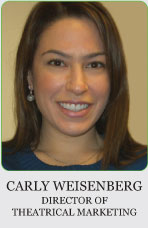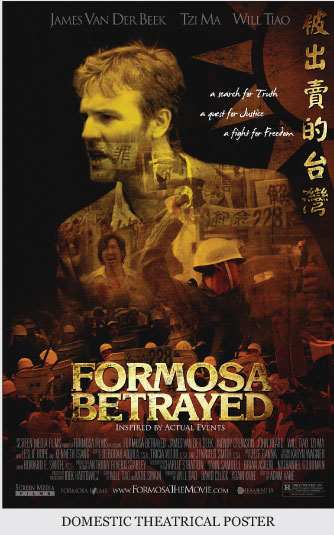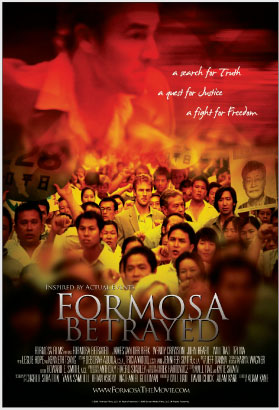 I had the pleasure of chatting with Caroline (Carly) Weisenberg, Director of Theatrical Marketing at New York-based distributor, Screen Media Films. Their impressive list of theatrical releases includes: Lymelife with Alec Baldwin and Emma Roberts; The Private Lives of Pippa Lee with Robin Wright and Keanu Reeves, and the upcoming James Ivory project City of Your Final Destination starring Anthony Hopkins and Laura Linney.
I had the pleasure of chatting with Caroline (Carly) Weisenberg, Director of Theatrical Marketing at New York-based distributor, Screen Media Films. Their impressive list of theatrical releases includes: Lymelife with Alec Baldwin and Emma Roberts; The Private Lives of Pippa Lee with Robin Wright and Keanu Reeves, and the upcoming James Ivory project City of Your Final Destination starring Anthony Hopkins and Laura Linney.
 Carly has been instrumental in the release of numerous theatrical and video titles at Screen Media, and is well versed in the nuances of independent theatrical marketing. I caught up with her recently to discuss the marketing of their latest project Formosa Betrayed, starring James Van Der Beek.
Carly has been instrumental in the release of numerous theatrical and video titles at Screen Media, and is well versed in the nuances of independent theatrical marketing. I caught up with her recently to discuss the marketing of their latest project Formosa Betrayed, starring James Van Der Beek.
Darryl - Screen Media picked up Formosa Betrayed after its world premiere at the Asian-American film festival. What attracted you to this film?
Carly - It’s a very good-looking film, and a good story, well told. It’s also an important story, as it’s based on actual events. Once we met with Will Tiao, producer and actor in the film, his passion and commitment sold us.
D - This project just landed on your desk. What process does your team go through to define a creative brief that determines the direction of the print campaign?
 C – Generally, we define our audience and then decide what story we want to tell with the artwork. Most of all, we want the art to be eye-catching and stand out.
C – Generally, we define our audience and then decide what story we want to tell with the artwork. Most of all, we want the art to be eye-catching and stand out.
D - What was the primary challenge in marketing Formosa Betrayed domestically? And what approach did you come up with to meet this challenge?
C - Formosa is our first bilingual film. We are used to English-language films that are more or less marketable to the masses. The main challenge for us was how to market the film to Asian-Americans. We needed someone familiar with this niche market, so we hired Telly Wong as a consultant. We also relied on Will’s expertise.
D - What is Telly’s expertise and how did he contribute to the marketing of the film?
C - Telly works for IW Group, a PR and communications firm that specializes in reaching the Asian-American community in the US. He’s worked on campaigns for corporate giants such as McDonald's, and also worked on the Samuel Goldwyn Film, Brotherhood of War.
We were originally going to include an image of an attractive woman in the art. Telly and Will felt that because we are marketing this film to Asian-Americans and their families, she should be excluded.
D - How did you decide which creative agency was the best candidate to create the key art?
C - We got lucky since the filmmakers had already used the design firm Dreamentia. Dreamentia had worked on their festival one-sheet and were already familiar with the campaign.
D - How much time does an agency have to put together the first round of poster explorations? How many comps (compositions) do you typically expect from them?
C - It really depends on the campaign. Sometimes we receive assets only a few months before the theatrical release date; sometimes we have plenty of time to work on a campaign. We generally ask for 5-7 comps initially.
D - You had a special photoshoot for this project. What made you decide to do one and what were the essential shots you wanted to get out of it?
C - Well, we knew that we would be using 2 campaigns—one for the theatrical, and one for international sales. We needed some clear shots of James and Will. Usually with independent films, we don’t find many usable shots of the actors. They are either too grainy, the lighting isn’t great, or they are simply not positioned how you want them. That’s why a photoshoot is ideal. You can arrange the lighting and position the actors where you need them to be.
D - So the international poster will be different than the one you’re using for the domestic campaign?
C - Yes. Buyers need an impactful marketing campaign that speaks to genres their audiences are familiar with.
D - Once you receive the first round of explorations, do you like to narrow in on just one composition or do you select a variety in which you want to see revisions?
C - Sometimes there is one comp that really stands out. We (and the designers) are lucky in those cases. At Screen Media, we also like to include the filmmakers in these decisions. No one knows a film like the director or producer, and it’s important that his or her vision comes through in the artwork.
D - How important is the title treatment to you? Some creative executives like to keep the title treatment (the film’s title) very simple, with an emphasis on readability – while others prefer something more definitive or iconic. Do you have a preference?
C - The title treatment is very important. It needs to evoke emotion, and act as a representation of the film. In the case of Formosa, we chose a gritty title treatment to represent the action in the film. For comedies, we tend to lean towards bright, bubbly lettering.
 D - When the final artwork is selected, do you feel that it’s an emotional decision based on what grabs you, or is it more of a rational verdict based on elements found in the artwork?
D - When the final artwork is selected, do you feel that it’s an emotional decision based on what grabs you, or is it more of a rational verdict based on elements found in the artwork?
C - That’s a great question. The decision needs to be a marriage of both. Again, it needs to be eye catching and represent the film, but at the same time there are contractual obligations that we need to follow.
D - Did contractual obligations affect your poster explorations? For example, were conceptual posters not an option because you had to feature the cast?
C - In this instance, we were lucky and had creative freedom. We could feature as many or as few actors as we wanted.
D - This film has an R rating. How did that affect what you can include in the poster? Did the MPAA request any revisions?
C - Yes. The one-sheet that was submitted to the MPAA was slightly different that what we ended up printing. The version we submitted was much bloodier. We had to tone down the blood, but were allowed to keep some of it due to that fact that the film is based on actual events.
D - What does an independent distributor do differently to market their films than the studios?
C - Speaking for Screen Media, we don’t have millions of dollars to spend on marketing campaigns. We identify our audience and spend money strategically. Before we write a check- we already know how that money will help our box office grosses. That’s not to say we won’t buy a billboard on the Long Island Expressway or national television spots.
D - I really like colors and the texture of your key art. For me this creates a strong sense of place and time. Can you tell us what elements of the final poster really sold you on the idea that this piece best represents the film?
C - Dreamentia included references to the 228 Incident, Taiwanese protestors, and Military police trying to quell those protesters… At the center of everything is an American FBI agent trying to solve a crime. This art epitomizes Formosa Betrayed.